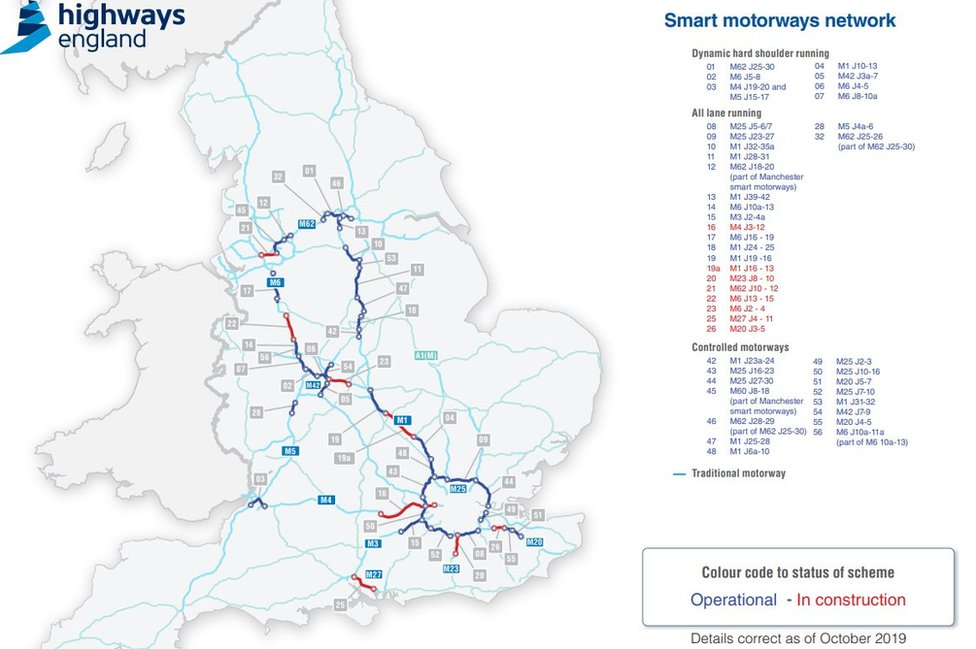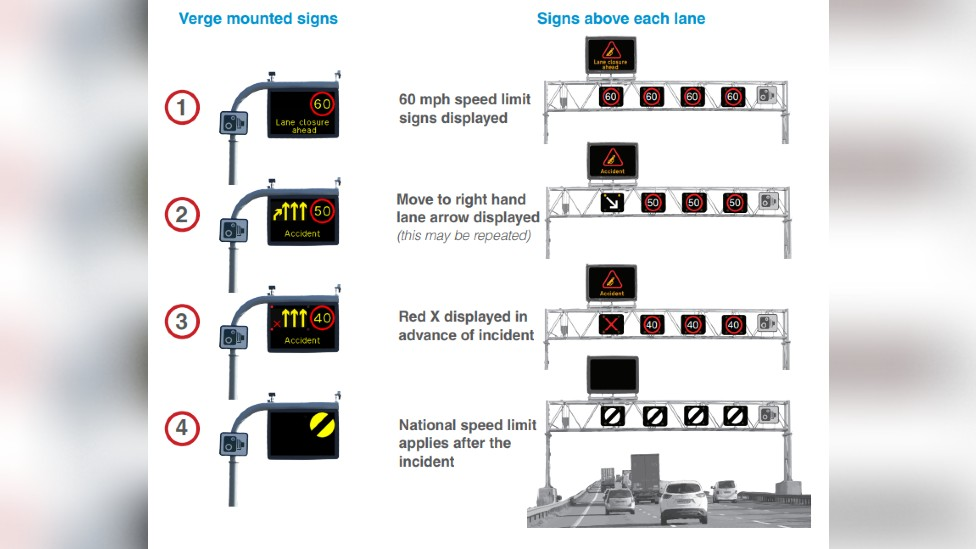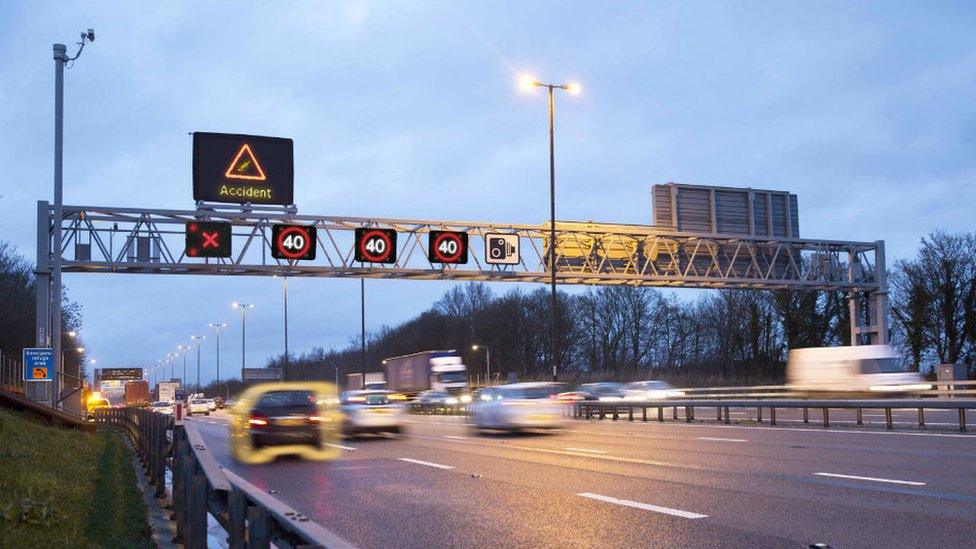What should you do if you break down on a smart motorway?
- Published

The revelation that 38 people have been killed on smart motorways in the last five years has renewed concerns about their safety - particularly when the hard shoulder is in use as an extra driving lane. So what should you do if you break down on a smart motorway and need to pull over in an emergency?
If your vehicle has a problem, get off the motorway immediately - that's the advice from Highways England.
Motorists are urged to make their way to one of the regularly spaced emergency areas at the side of the carriageway on smart motorways, which are marked with blue signs and an orange SOS telephone symbol.
If drivers are moving at 60mph (97km/h), they should be able to reach a refuge every 75 seconds on average, according to the agency. Once they reach it safely, there is a phone to ring them.

Emergency areas are marked with blue and orange signs
If you can't get to an emergency area but your vehicle can be driven, the advice, external is to pull up as close as possible to the nearside (left hand) verge or other nearside boundary or slip road.
Switch on hazard lights and rear fog or side lights, especially if visibility is low.
The driver and any passengers should get out of the vehicle if it feels safe to and wait at the other side of the safety barrier if there is one, so they are clear of their vehicle.
If it does not feel safe enough to get out - or if the breakdown occurs in the middle or outside (right hand) lanes - motorists should keep seatbelts on, turn on hazard warning lights and contact 999 immediately.
In this instance, smart motorway technology can assist quickly with lane closures, as regional control centres use CCTV cameras to monitor and manage these stretches.
"Once they're aware of your situation, they can set overhead signs and close the lane to help keep traffic away from you," Highways England said.
"If you break down or are in an emergency, you must call for help as soon as possible."
Where are smart motorways?

Smart motorways now cover more than 400 miles (640km) of England, with the above map the most up to date, according to Highways England.
There are three types of smart motorway, namely:
Controlled - people cannot drive in the hard shoulder
Dynamic hard shoulder - the hard shoulder can be opened
All lanes running (ALR) - the hard shoulder has permanently become a lane
England currently has more than 100 miles (161km) of ALR smart motorways.
They are:
M1: J16 to 19, J23a to 25, J28 to 31, J32 to 35a, J39 to 42
M3: J2 to 4a
M5: J4a to 6, J15 to17
M6: J10a to 13, J16 to 19
M25: J5 to 7, J23 to 27
M62: J25 to 26
How do smart motorways work?

Signs alert drivers to changes to the motorway
Smart motorways can change to suit the traffic, for example extra lanes can be opened or speed limits changed.
Highways England said they were an effective way of improving flow and journey times as well as alerting drivers to hazards further ahead.
They are controlled from centres with computers monitoring the traffic and, when necessary, adjust the speed limits to a minimum of 40mph.
The decision to open and close lanes is done by people working in the control centres who rely on CCTV and reports from police and the public.
Signs direct drivers on speed limits and which lanes are open, with a red X signifying a lane is closed, as well as warnings of upcoming hazards.
Highways England said smart motorways have reduced accidents causing injuries by more than a half, external.
You might also be interested in
Why don't some people like them?

Both the AA and RAC are calling for changes
Both the RAC and AA have expressed serious reservations about the loss of the hard shoulder.
Nicolas Lyes, head of roads policy at the RAC, said more than two thirds of drivers surveyed, external felt the removal of the hard shoulder "compromises safety", while breaking down in a live lane carries a "much higher risk" than on a hard shoulder or in an emergency area.
"It is abundantly clear things need to change," he said.
"We have consistently called for the roll-out of stopped vehicle detection radar technology to quickly identify stranded vehicles, and additional SOS areas to give drivers a greater chance of reaching one in the event of an emergency, thereby reducing the collision risk."
The AA also wants emergency areas to be installed every three quarters of a mile, claiming they are currently about a mile and a half apart.
Its president Edmund King said: "Drivers don't trust smart motorways and with 38% of breakdowns occurring in live lanes that is not surprising. There is much confusion and fear out there.
"The current system is not fit for purpose and too many tragic and avoidable deaths are occurring."
Rotherham MP Sarah Champion has also called for the end of smart motorways saying it is "totally unacceptable to risk lives in the name of saving costs".
Transport Secretary Grant Shapps previously told BBC Panorama he wants to fix smart motorways because they are too confusing for drivers.
- Published26 January 2020

- Published30 June 2019

- Published22 January 2020
